Yes, your smart toaster can potentially be hacked, especially if default passwords, weak security settings, or outdated firmware remain unchanged. Hackers may exploit vulnerabilities in connected devices to gain access, control your appliances, or breach your network, risking privacy and security. These risks highlight the importance of securing all devices with strong passwords, regular updates, and proper network isolation. If you want to uncover how these threats unfold and how to protect yourself, there’s more to explore.
Key Takeaways
- Even simple smart appliances like toasters can be hacked if connected insecurely or with default passwords.
- Hackers may exploit vulnerabilities to control or disrupt smart toasters, posing privacy and safety risks.
- Firmware gaps and lack of security updates increase the likelihood of unauthorized access to smart appliances.
- Weak security protocols can allow hackers to use smart toasters as entry points into your home network.
- Regularly updating device firmware and changing default credentials enhances protection against potential hacks.
How Smart Devices Connect and Communicate
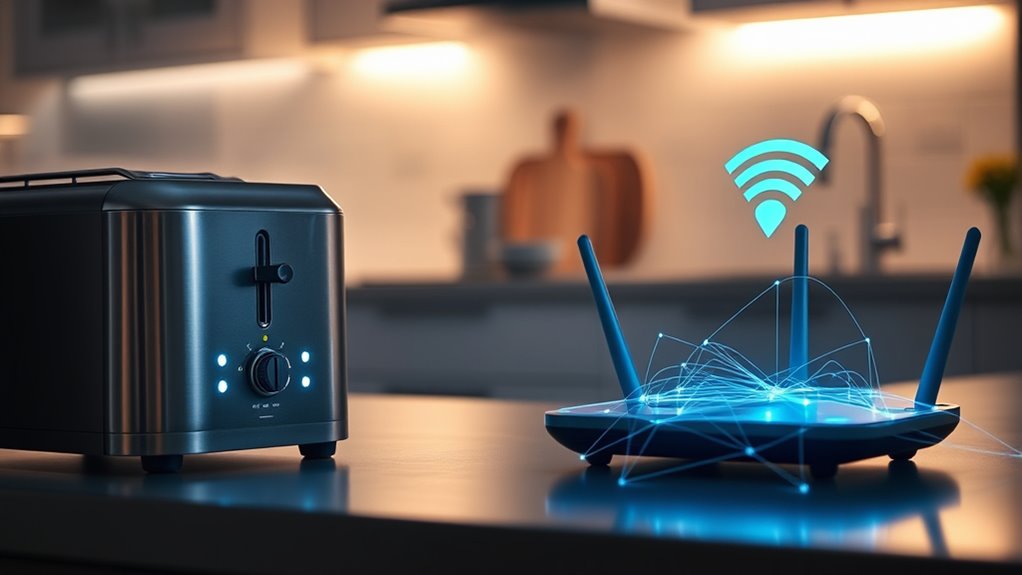
Smart devices connect and communicate through various protocols that enable seamless data exchange. Device pairing is a vital step, allowing your gadgets to recognize and trust each other securely. During pairing, devices often exchange keys and information to establish a trusted connection. Encryption protocols come into play here, protecting the data transmitted between devices from eavesdropping or tampering. These protocols scramble the information, making it unreadable to outsiders. When you set up a smart device, you might notice prompts for pairing or encryption confirmation, ensuring your connection stays private. Understanding how device pairing and encryption protocols work helps you appreciate the importance of secure communication and highlights the need for robust security measures in your smart home ecosystem. Additionally, security protocols help prevent unauthorized access and potential hacking attempts, safeguarding your connected devices.
Common Vulnerabilities in IoT Gadgets
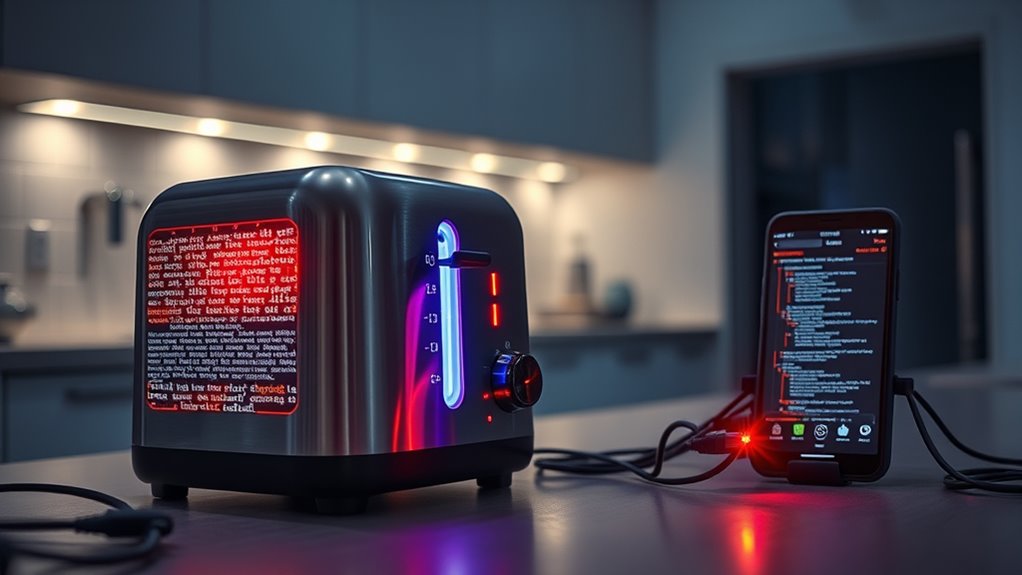
Many IoT gadgets have weak default passwords, making it easy for hackers to gain access. Insecure network connections also put your devices at risk of interception and manipulation. Additionally, firmware update gaps leave vulnerabilities unpatched, exposing your smart home to potential threats. Moreover, many devices lack color accuracy calibration features, which can be exploited for malicious purposes if compromised.
Weak Default Passwords
Have you ever overlooked changing the default password on your IoT devices? Default passwords are often simple and widely known, making it easy for hackers to access your gadgets. Weak default passwords compromise your device’s security, regardless of its capabilities. To improve safety, always set a unique, strong password that’s difficult to guess. Here’s a quick comparison:
| Device Type | Default Password | Suggested Password |
|---|---|---|
| Smart Thermostat | admin | T!m3n0w2024! |
| Security Camera | 1234 | S3cureC@m3ra!2024 |
| Smart Toaster | toaster | ToastY!2024 |
| Voice Assistant | password | Voic3H@ckPr00f! |
Strengthening your default passwords substantially reduces hacking risks. Regularly updating your passwords also enhances your device security and protects your privacy.
Insecure Network Connections
Insecure network connections pose a significant threat to IoT device security because they can be exploited by hackers to gain unauthorized access. When your devices lack encrypted communication, sensitive data like passwords or personal info can be intercepted easily. Without secure channels, attackers can eavesdrop on network traffic and manipulate data. Implementing network segmentation helps isolate IoT gadgets from your main network, reducing the risk if a device is compromised. This way, even if a hacker infiltrates one device, they can’t easily access your other devices or sensitive information. Always guarantee your IoT devices use encrypted communication protocols and adopt network segmentation strategies to strengthen your smart home’s defenses against cyber threats.
Firmware Update Gaps
Even with secure network connections in place, your IoT devices can remain vulnerable if their firmware isn’t regularly updated. Firmware vulnerabilities often stem from outdated software that hackers can exploit. Many devices lack robust update protocols, leaving security gaps open. To minimize these risks, consider these steps:
- Regularly check for firmware updates from manufacturers.
- Enable automatic updates when available.
- Review update protocols to ensure they use secure methods.
- Delete devices that don’t support proper firmware management.
- Use vetted conversion kits to ensure compatibility and reliability, reducing the risk of security flaws stemming from incompatible or poorly supported hardware.
Neglecting firmware updates exposes your smart home to potential breaches, as hackers target known vulnerabilities. Staying proactive with firmware management helps close security gaps and keeps your IoT gadgets safer from cyber threats.
Real-World Incidents of Smart Home Hacking

Recent incidents have demonstrated how vulnerable smart home devices can be to cyberattacks. Hackers have exploited these vulnerabilities to take control of devices like thermostats and security cameras, disrupting innovative automation systems you rely on daily. In one case, attackers gained access to a smart thermostat, disabling energy efficiency features and causing temperature fluctuations. Others have hijacked security cameras, spying on residents or even using them as entry points for deeper breaches. These incidents highlight that your smart home’s convenience can come at a cost. As cybercriminals target these devices, it’s clear that even the most advanced automation systems aren’t immune. Strengthening device security through ethical hacking techniques can help identify and address vulnerabilities before malicious actors do. Staying aware of these threats helps you understand the importance of strong security measures to protect your connected home.
Risks of Unauthorized Access and Data Breaches
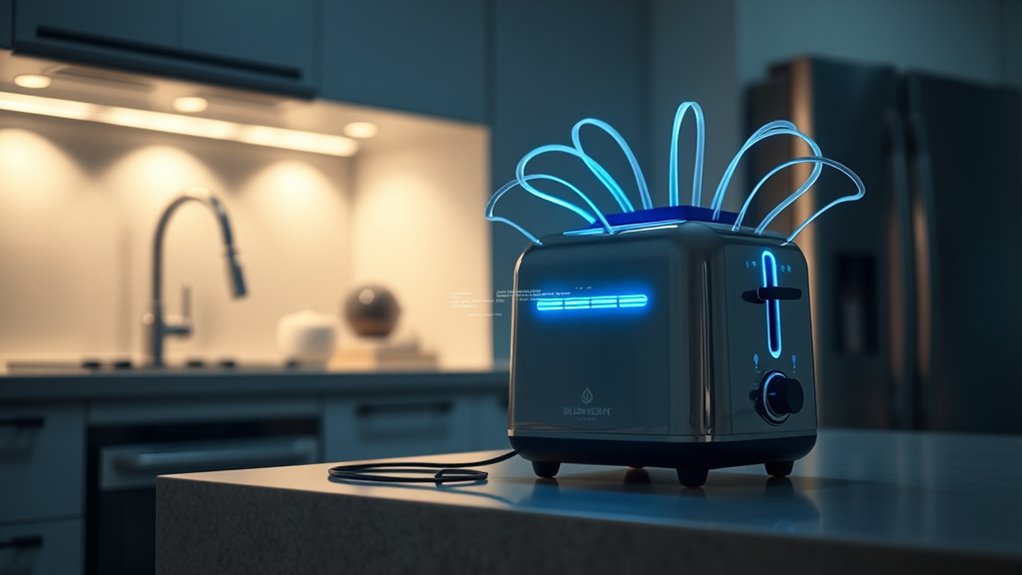
When hackers gain unauthorized access to your smart home, they can control devices or even enter your property. This puts your privacy at risk and can lead to significant data loss. Understanding these threats helps you take steps to protect your personal information and home security. Regularly updating your device firmware and employing security measures can reduce vulnerabilities to hacking attempts.
Potential for Unauthorized Entry
Smart homes are increasingly connected, which makes them vulnerable to unauthorized entry through hacking. If security measures like device isolation are weak, hackers can exploit gaps to access your network. Poor user authentication can allow intruders to bypass protections and control your devices remotely. To reduce risks, consider these precautions: 1. Ensure proper device isolation so hackers can’t move laterally within your network. 2. Use strong, unique passwords and enable multi-factor authentication. 3. Regularly update your device firmware to patch security vulnerabilities. 4. Limit access permissions and disable unused features to minimize attack vectors. Trustworthiness of Patchology can serve as a reminder to choose reputable brands and secure your digital devices effectively.
Privacy and Data Loss
Have you ever considered how easily personal data stored in your smart home can be compromised if hackers gain unauthorized access? Without proper device encryption, sensitive information like your schedules, habits, and even financial details can be exposed. Hackers can exploit vulnerabilities to access your data, risking your user privacy. When your devices lack robust encryption, your personal information becomes an open book for cybercriminals. Data breaches not only threaten your privacy but can also lead to identity theft or financial loss. Ensuring your smart home devices use strong encryption helps protect your data from unauthorized access. Staying vigilant about security updates and choosing devices with built-in privacy safeguards is vital in safeguarding your personal information from the dark side of smart homes. Regularly reviewing your device security settings and understanding security protocols can further enhance your protection.
The Role of Weak Passwords and Default Settings
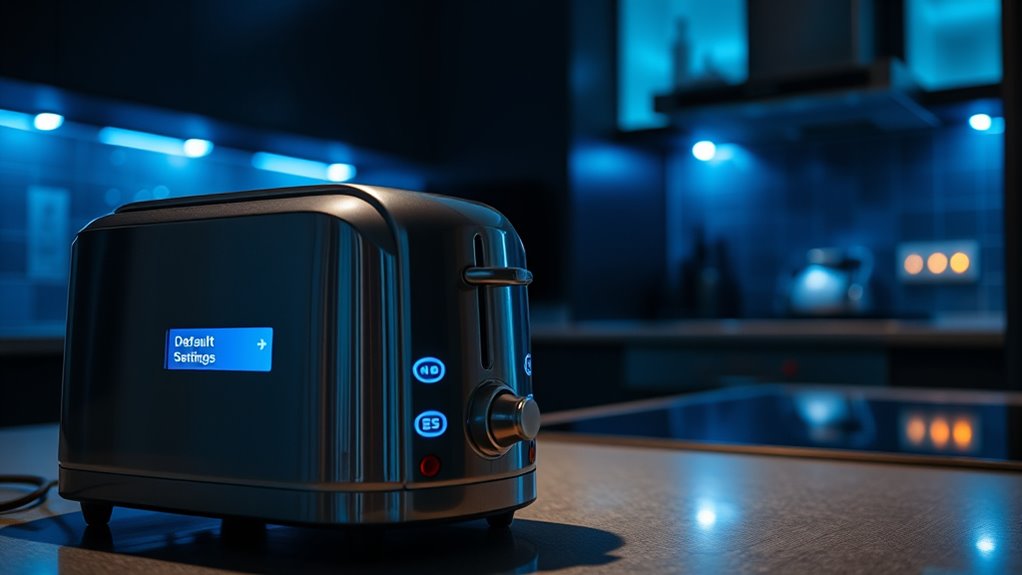
Weak passwords and unchanged default settings are major vulnerabilities in smart home security. Many devices come with default credentials that are easy to find online, making them attractive targets. Using simple passwords reduces password complexity, increasing the risk of brute-force attacks. To protect yourself, consider these steps:
- Change default credentials immediately after setup.
- Use strong, unique passwords for each device.
- Avoid common passwords like “password” or “123456.”
- Enable two-factor authentication if available.
- Regularly update device firmware to patch security flaws and close potential security vulnerabilities.
Default settings are often left unchanged because they’re convenient, but they compromise your security. Weak passwords and default configurations are low-hanging fruit for hackers aiming to access your smart home. Taking control of these areas markedly improves your defenses against intrusions.
Protecting Your Devices: Best Practices and Tips

To effectively protect your devices, start by keeping their firmware and software up to date, as manufacturers regularly release security patches that fix vulnerabilities. This helps prevent hackers from exploiting known flaws. When setting up voice command features, guarantee you enable two-factor authentication if available, and be cautious about voice data privacy. Make sure your device pairing process is secure—use strong, unique passwords and avoid casual connections. Regularly review connected devices and remove any unfamiliar or unused ones. Change default settings that could be exploited, and disable features you don’t use. Additionally, understanding the horsepower of electric dirt bikes can help you select safer, more reliable models for off-road use. By staying vigilant with updates, secure device pairing, and careful voice command management, you reduce the risk of unauthorized access and help keep your smart home safer.
The Future of Secure Smart Home Technology

As smart home technology continues to evolve, security measures are becoming more advanced and integrated. Future innovations will focus on making your devices smarter and safer. For example:
- Voice recognition will improve, allowing only authorized users to control devices, reducing hacking risks.
- Energy optimization features will be more secure, ensuring your data stays protected while saving power.
- Enhanced encryption protocols will guard against breaches, keeping your smart home private.
- IoT devices will incorporate adaptive security systems that learn and respond to threats in real-time.
These advancements aim to create a seamless, secure experience, giving you peace of mind while enjoying the benefits of a truly connected home.
How to Detect and Respond to a Security Breach
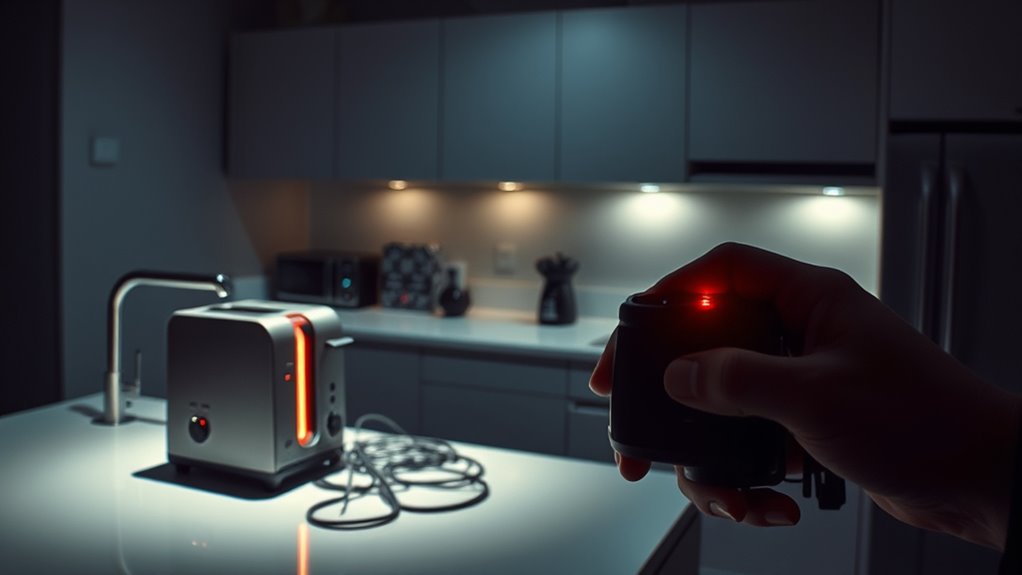
While advanced security features help protect your smart home, no system is completely invulnerable. To detect breaches, you should regularly monitor device behavior for anomalies, like unexpected activity or unfamiliar connections. Behavior monitoring tools can alert you to unusual patterns that might indicate hacking attempts. If you notice suspicious activity, act swiftly by disconnecting affected devices and changing passwords. Developing an incident response plan ensures you know what steps to take, including notifying your security provider or authorities if needed. Keep logs of incidents to track patterns and improve defenses over time. Prompt detection and a clear response can limit damage, prevent further intrusion, and help restore your smart home’s security quickly.
Building a Safer Connected Home Environment
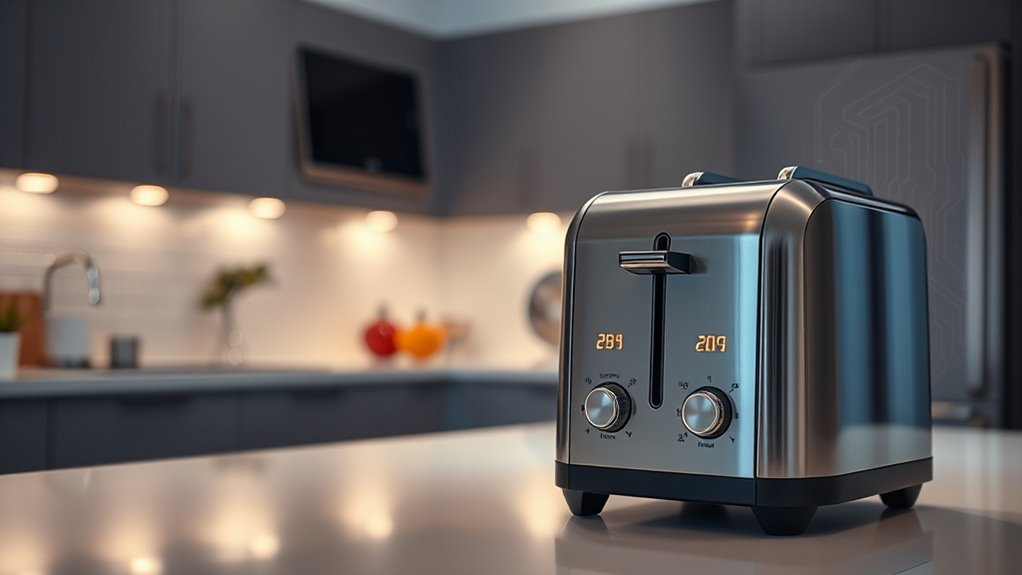
Creating a safer connected home environment requires proactive steps to minimize vulnerabilities and enhance security. To do this, focus on strengthening device pairing protocols, which help prevent unauthorized access. Be cautious of voice command vulnerabilities; avoid using voice controls in insecure locations or with sensitive information.
Enhance home security by strengthening device pairing and limiting voice command access.
Consider these steps:
- Update all device firmware regularly to patch security flaws.
- Use strong, unique passwords for each device and account.
- Enable two-factor authentication where possible.
- Disable unnecessary voice commands and restrict voice access to trusted users.
Frequently Asked Questions
Can Smart Appliances Secretly Record My Daily Activities?
You might wonder if smart appliances secretly record your daily activities. While these devices can collect data for functionality, privacy concerns arise because they often transmit information to servers without clear user consent. Your smart toaster, for example, could potentially gather data about your routines. It’s important to review privacy policies and disable unnecessary data collection features to protect your privacy and maintain control over your personal information.
Are There Specific Brands More Vulnerable to Hacking?
Imagine your smart fridge suddenly freezes and displays strange messages—that’s a hacking hotspot. Certain brands, like those with outdated security protocols or poor firmware updates, are more vulnerable to hacking. These brand vulnerabilities make them prime targets for cybercriminals. Research shows that popular, widely-used brands often become hacking hotspots because hackers see more opportunities. Always keep your devices updated and choose reputable brands to reduce risks.
How Often Should I Update My Smart Home Devices?
You should update your smart home devices regularly to stay protected. Aim for a device update frequency of at least once a month, or as soon as security patch schedules are announced. These updates fix vulnerabilities and improve security. Don’t ignore notifications about firmware or software updates, as staying current helps prevent hackers from exploiting outdated software. Making updates a routine part of your smart home maintenance keeps your devices safer.
Do Smart Home Hacks Pose Physical Safety Threats?
Smart home hacks can pose real physical safety threats. If hackers gain control, they could manipulate devices like locks, thermostats, or even security cameras, leading to unauthorized surveillance or safety risks. Privacy concerns increase when hackers access your personal data or monitor your activities. You need to secure your devices with strong passwords and keep updates current to reduce these risks, ensuring your home remains safe and private.
Is It Legal for Hackers to Access My Smart Devices?
While it might feel like a secret adventure, hacking into your smart devices isn’t just risky—it’s illegal. Engaging in such activities can lead to serious legal implications and privacy violations, which could disrupt your life considerably. Always remember, respecting digital boundaries keeps your smart home safe and secure. Instead, focus on protecting your devices with strong passwords and regular updates to enjoy the convenience without crossing legal lines.
Conclusion
So, go ahead—leave that smart toaster unattended, because who needs privacy when you can enjoy the thrill of potential hacking? After all, it’s just your entire home’s security on the line. Remember, in the world of IoT, a weak password is the new black, and default settings are just fashion statements. Stay vigilant, or soon enough, your gadgets might be smarter than you, and just as mischievous. Happy hacking-proof living!









